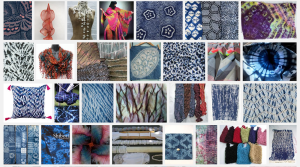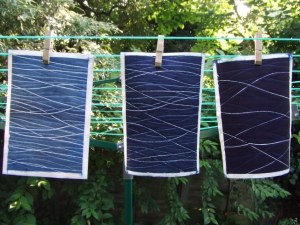10th International Shibori Symposium Exhibitions
This is a guest post by Kim of Flextiles. She recently attended the Tenth International Shibori Symposium and I thought you all might to get a glimpse of what she did and saw there. Thanks Kim!
My previous post about the 10th International Shibori Symposium (10iss) in Mexico last November focused on some of the workshops I attended. This time I’m going to report on some of the inspiring exhibitions and beautiful work on show.
Several of the exhibitions were in the Centro de las Artes de San Agustin (CASA), around 45 minutes’ drive from the centre of Oaxaca. It’s a former cotton mill that was converted into a stunning arts centre by local artist Francisco Toledo in 2000. Its hilltop location gives amazing views, and it has two exhibition halls and smaller rooms for running workshops.
Here there was a wonderful exhibition, curated by Yoshiko Nakamura and Consortium Arimatsu Narumi, of historical and modern Japanese indigo-dyed kimono from Arimatsu and Narumi in Japan.
Another exhibition here showcased 12 pieces of clothing designed by Mexican designer Carla Fernandez, highlighting connections between the Mexican and Japanese traditions of ikat (known as jaspe in Mexico and kasuri in Japan).
The contemporary garments were wonderful, combining Japanese silhouettes and designs with traditional Mexican rebozo patterns.
The main exhibition hall at CASA was given over to a wide range of contemporary shibori artworks and wearables, curated by Yoshiko Wada and Trine Ellitsgaard. Unfortunately, the evening viewing I went to was quite dark, so I found it tricky to get decent photos, but here’s a flavour of some of the pieces on display.
A short walk downhill from CASA is the paper making cooperative Arte Papel Vista Hermosa, also founded by Francisco Toledo. Its members use bark, plants, flowers, cotton, hemp, silk, linen and pieces of shiny mica in their products. As well as seeing the artisans at work, visitors can have a go at making paper themselves.
For this exhibition they worked with artist Kiff Slemmons to produce some stunningly intricate paper jewelry. And yes – I did end up buying a piece! 🙂
Back in town, the Textile Museum of Oaxaca was, unsurprisingly, the main exhibition focus. One of the most eye-catching was an installation of bandhani flags by Christina Kim. This was a collaboration between artisans in Kutch in Gujarat and the National Institute of Design in Ahmedabad to employ women displaced by the 2001 earthquake in Kutch. Fluttering against the blue sky, the flags were a stunning sight.
The second exhibition was an interesting cross-cultural comparison of shibori and ikat techniques from around the world. While I know something of the Japanese and Indian traditions, I was less familiar with jaspe, the Mexican equivalent of ikat.
Ikat is the process where (usually) sections of the warp threads are bound with threads before dyeing, forming a pattern that will show after weaving. Sometimes the weft threads are dyed, and sometimes both warp and weft – this is known as double ikat (or patola in India).
It’s immensely disciplined because you have to know exactly where the dyed threads will end up in the final piece – no changing your mind (or pattern) once you start! The resulting designs tend to look a little “fuzzy” around the edges.
Shibori pieces on display ranged from a Japanese kanoko shibori jacket to raffia- stitched fabric from Africa.
Finally, there was a fascinating exhibition on the plumed weavings of Mexico. In the 1980s, a fragment of fabric woven with a mixture of cotton and duck down was found in a flea market in Puebla. The technique seems to have been unique to Mexico, and the exhibition displayed work by modern weavers incorporating duck down.
There is a website here explaining the process, but it is all in Spanish.
If you have any questions, please feel free to comment and Kim will answer you. Thanks for the post Kim!

























































